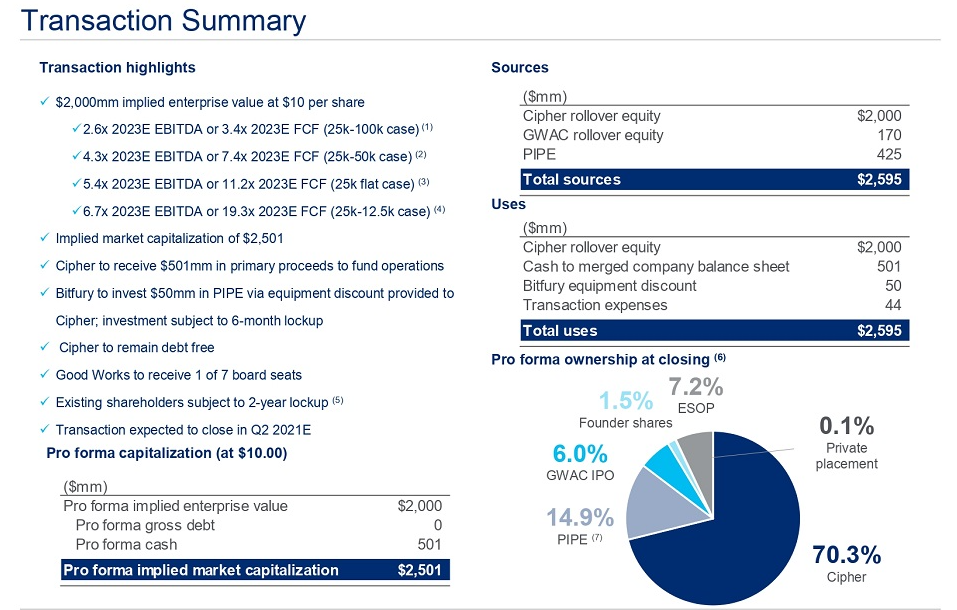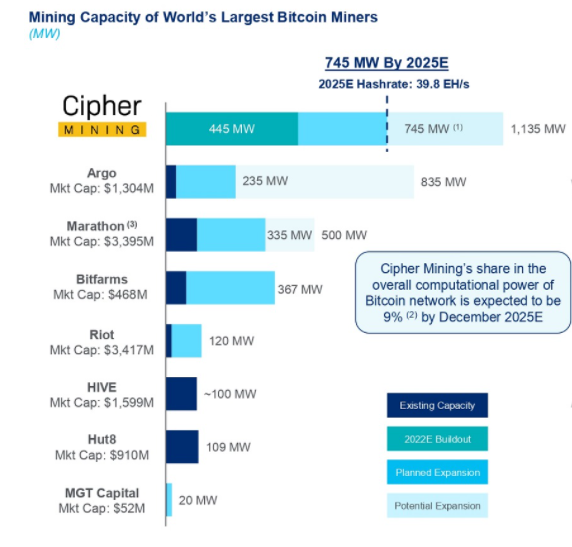On March 5, another special purpose acquisition company (SPAC) deal was announced, this one involving a newly formed U.S.-based Bitcoin mining operation called Cipher Mining. The real news is that this transaction, unlike many of the other SPACs created over the last few months, looks reasonably, even attractively, valued.
Cipher, a subsidiary of the Bitcoin mining computer manufacturer Bitfury Group, merged with Good Works Acquisition Corp. (NASDAQ: GWAC). Upon the expected 2Q 2021 closing of the transaction, the resultant company will be named Cipher Mining Inc. and will trade on the NASDAQ under the symbol CIFR.
The Cipher SPAC transaction implies a stock market capitalization of US$2.501 billion. The company will have pro forma cash of US$501 million and no debt, meaning its enterprise value will be US$2.0 billion.

In a SPAC, a group of investors raise money for a shell company with no underlying business. The SPAC then goes public and begins to search for a company to acquire. When the public SPAC finds a target and reaches a deal, the SPAC and the target reach out to potential investors for funds which is called a PIPE (private investment in public equity). The PIPE investors get a large equity stake, and the SPAC investors get stock in the acquired company, which becomes the publicly traded entity.
Cipher plans to use its cash to purchase mining equipment from Bitfury. Based on the market prices of that equipment, and factoring in contractual equipment discounts from Bitfury, Cipher could feasibly acquire the 39.8 Exahash per second (EH/s) of computing power it forecasts it will have by year-end 2025 by depleting that cash balance only — and without raising additional financing. (Bitfury does not quote prices on its website, but using the prices quoted by a competitor, MicroBT, on its website, the cost to acquire state-of-the-art computing capacity is around US$1.6 million per EH/s– before any discounts.)

Cipher Could Generate Significant Cash Flow
In the financial model below, we calculate the operating cash flow that 39.8 EH/s of Bitcoin mining could generate based on:
- 1) the current Bitcoin spot price of US$49,190;
- 2) a projected December 31, 2025 Bitcoin network hashrate of 455 EH/s, about triple the current level of 157 EH/s, to account for rapid growth in Bitcoin mining activity;
- 3) locked-in electricity costs of about $0.027 per kilowatt-hour; and
- 4) the effects of the next Bitcoin halving event in May 2024. The network hashrate is an estimate of how many hashes are being generated by all Bitcoin miners trying to solve the current Bitcoin block.
| POTENTIAL 2026E PROFITABILITY OF CIPHER MINING | ||
| Projected Bitcoin Network Hashrate at 12/31/25E | 455 | EH/s |
| Potential Cipher Mining Hashrate at 12/31/25E | 39.8 | EH/s |
| Percentage That Cipher Would Represent of the Total Bitcoin Network Hashrate | 8.7% | |
| Number of Bitcoin Awarded Per Block in Late 2025E, Awarded Every 10 Minutes | 3.125 | Bitcoin |
| Average Transaction Fees Per Block | 0.9426 | Bitcoin |
| Total Bitcoin Awarded Every 10 Minutes | 4.0676 | Bitcoin |
| Daily Block Reward – Systemwide | 586 | Bitcoin per day |
| Number of Bitcoin That Cipher Mining is Expected to be Awarded Per Day in 2026E | 51.2 | Bitcoin per day |
| Bitcoin Spot Price, US$ | $49,190 | |
| Expected Revenue Per Day, in US$ | $2,520,283 | |
| Costs: | ||
| Power Consumption | 745 | Megwatts (MW) |
| Average Electricity Price Per Kwh, in US$ | $0.027 | per Kwh |
| Daily Electricity Cost, in US$ | $482,760 | |
| Mining Profit Per Day in 2026E, in US$ | $2,037,523 | |
| Annualized 2026E Mining Profit, in US$ milions | $744 | |
| Present Value of 2026E Mining Profit Using 20% Discount Rate, in US$ millions | $299 | |
| Sensitivities: | ||
| Each US$10,000 Change in Bitcoin Price Affects 2026E Profit by About, in US$ millions | $190 | |
| Each US$10,000 Change in Bitcoin Price Affects NPV of 2026E Profit by About, in US$ millions | $75 | |
| Each 10% Increase in Bitcoin Network Hashrate Decreases 2026E Profit by About, in US$ millions | $80 |
Cipher could generate annual operating cash flow of nearly US$750 million in 2026. If we apply a conservative 20% discount rate to that figure, that “equates” to a present value EBITDA run rate of around US$300 million. Pursuing this further, this implies that Cipher is currently trading at a little less than a 7x enterprise value-to-“adjusted” EBITDA ratio, a moderate figure for a well-capitalized growth company.
Each US$10,000 change in the price of Bitcoin would impact Cipher’s 2026E cash flow and the present value of that 2026E cash flow by about US$190 million and US$75 million, respectively.
Sensitivity to Bitcoin pricing represents Cipher’s chief risk. For example, if the digital currency were to be cut in half from current levels, the company’s 2026E cash flow would be only around US$260 million, and the present value of that cash flow would similarly be reduced to around US$115 million.
The Cipher Mining SPAC seems to be priced more attractively than many other SPACs. If the price of Bitcoin holds at around current levels, or even decreases moderately, the future cash flow should be robust, and the company’s future cash flow multiple looks to be fairly modest, based on the assumptions made above.
Good Works Acquisition Corp. last traded at US$11.14 on the NASDAQ.
Information for this briefing was found via Sedar and the companies mentioned. The author has no securities or affiliations related to this organization. Not a recommendation to buy or sell. Always do additional research and consult a professional before purchasing a security. The author holds no licenses.





2 Responses
How does this industry justify the environmental cost of this mining? What are they going to do about it?
I hope crypto moves to a greener network like Chia (chia.net for more info). With proof of work like bitcoin, all these miners are using high powered GPU’s to calculate each new block on the blockchain, and throwing it out to recalculate the next block, whether they win or lose. Chia uses proof of space and time instead, where the caluclations are done up front and saved to disk, so for each block, you check your existing proofs for a winner, and they’re reusable. Bitcoin is such old tech, it’s unfortunate everybody insists on using it.